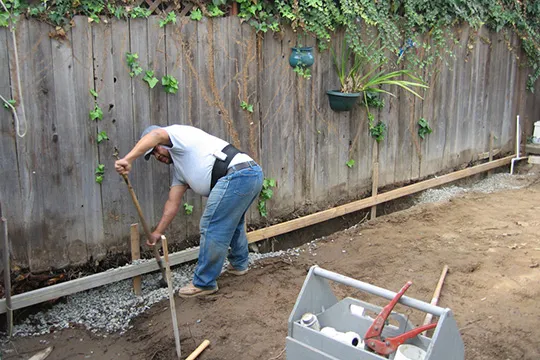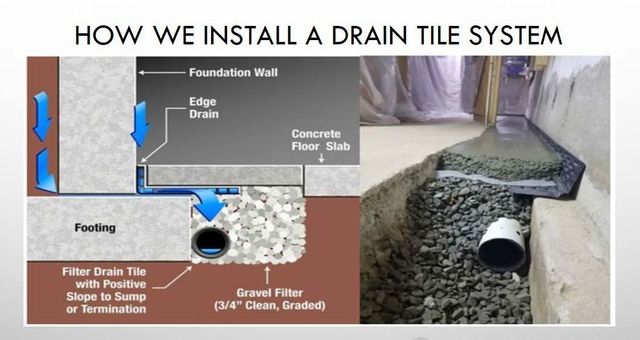Solve Drain Troubles Permanently with a Modern French Drain System
Solve Drain Troubles Permanently with a Modern French Drain System
Blog Article
Understanding the Significance of a Septic Tank French Drain for Effective Wastewater Monitoring
The combination of a septic container French drain system plays an essential duty in efficient wastewater monitoring, yet its significance is usually ignored. This system not just facilitates the therapy of sewage but also effectively manages excess water, reducing potential environmental risks. Understanding the technicians and advantages of such a system can brighten its essential duty in stopping dirt saturation and improving groundwater quality. Nonetheless, ignoring its maintenance can result in major difficulties that might undermine these benefits. What are the details difficulties one might encounter without this important part?
What Is a Sewage-disposal Tank French Drain?
A septic system French drain is a customized drain system designed to manage wastewater and stop flooding in locations where standard drainage methods may be inadequate. This system integrates the capabilities of a standard sewage-disposal tank with a French drain, permitting reliable wastewater therapy and efficient water diversion.

Created making use of perforated pipelines stocked crushed rock trenches, a French drainpipe facilitates the motion of water away from essential areas. It permits the infiltration of excess water into the bordering dirt, advertising efficient drain while protecting the septic tank's honesty. The mix of these two systems is specifically advantageous in areas with hefty rains or bad drainage, making sure the durability and functionality of wastewater management systems while guarding public health and the environment.

Exactly How It Functions in Wastewater Monitoring
In wastewater management, the integration of a septic container and French drainpipe plays an important function in guaranteeing efficient treatment and disposal of sewage. The septic container offers as the very first line of protection, where wastewater undertakes preliminary therapy via sedimentation and anaerobic food digestion.
When the wastewater is clarified, it flows into the French drainpipe system, which is developed to help with additional treatment and safe dispersal. The French drainpipe contains perforated pipes hidden in gravel or rock, allowing cured effluent to percolate into the bordering dirt. This all-natural filtering process help in the removal of pathogens and nutrients, promoting groundwater recharge and reducing the risk of surface area contamination.
With each other, the septic system and French drainpipe produce a sustainable method to wastewater management, minimizing environmental effect while ensuring conformity with wellness regulations. This incorporated system not just safeguards public wellness yet likewise keeps the stability of neighborhood ecosystems.
Advantages of a French Drain System

The French drainpipe system supplies various benefits that boost both wastewater management and ecological protection. Mainly, it effectively redirects water far from crucial locations, decreasing the risk of flooding and dirt saturation that can endanger septic tanks. This aggressive drain solution aids preserve the integrity of the septic system by avoiding excess dampness, which can lead to system failure.
In addition, a correctly installed French drainpipe minimizes the capacity for groundwater contamination. By carrying wastewater far from the building, it decreases the possibility of pollutants going into regional water resources, hence safeguarding public health and wellness and keeping ecological equilibrium. The system additionally improves the appearances and functionality of exterior spaces by avoiding water build-up, which can develop muddy locations or unsightly puddles.
Furthermore, French drains pipes call for reasonably low upkeep compared to various other water drainage options, making them an affordable long-lasting financial investment. Their versatility permits them to be used in various landscapes, suiting both commercial and residential homes. Eventually, the benefits of a French drainpipe system expand beyond instant drainage needs, contributing to sustainable wastewater monitoring techniques and promoting environmental stewardship.
Typical Issues Without a French Drain
Ignoring the installation of a French drain can cause substantial obstacles in taking care of water circulation and keeping dirt integrity. One of the key concerns is the build-up of excess surface area water, which can develop swamping or pooling in backyards, particularly after heavy rains. This stagnation can saturate the dirt, causing disintegration and jeopardizing the foundation of nearby frameworks.
Additionally, without a French drainpipe, groundwater can incorrectly infiltrate septic tanks, raising the threat of system failure. The resulting backup can cause unpleasant odors, wellness dangers, and costly repair services. Poor drain can also advertise the growth of mold and mold, which can negatively influence interior air high quality and pose wellness risks to occupants.
On top of that, the lack of a correct drain system may motivate the proliferation of insects and pests, attracted to standing water. Plant life may have a hard time to prosper because of fluctuating dampness levels, causing a neglected landscape. Inevitably, the absence of a French drain can result in why not try this out a series of structural and ecological issues that require substantial intervention and expense to correct. Carrying out a French drainpipe system is vital for efficient wastewater monitoring and building security.
Upkeep Tips for Homeowners
Regular upkeep of a French drainpipe is important to guarantee its optimum efficiency and long life. Home owners should routinely examine the drain for any type of indicators of obstruction or damage. This includes monitoring for debris accumulation, which can hamper water flow. Think about using a high-pressure water jet to get rid of the drain. if debris is present.
Furthermore, it is important to keep the location around the French drainpipe devoid of particles, such as leaves, soil, and other raw material. This will protect against clogging and permit effective water drain. Regularly trimming plant life and planting far from the drain can likewise alleviate root breach.
Additionally, home owners need to monitor the performance of their French drainpipe after heavy rains. Observing how well water is directed far from the septic tank can offer insights right into its functionality. If merging water is kept in mind, it might indicate a requirement for specialist evaluation.
Last but not least, consider scheduling regular specialist examinations to assess the total condition of the drainpipe. Such aggressive steps will certainly aid maintain the effectiveness of your French drain and make sure reliable wastewater monitoring for years ahead.
Conclusion
In final thought, the septic container French drainpipe system plays a vital role in effective wastewater administration by ensuring proper treatment of sewage and effective water diversion. In general, the septic storage tank French drain represents a sustainable solution that profits both household and business homes across various landscapes.
The integration of a septic storage tank French drain system plays a crucial function in efficient wastewater administration, yet its significance is typically neglected. Inevitably, the benefits of view website a French drainpipe system extend beyond immediate drainage demands, contributing to lasting wastewater monitoring practices and advertising environmental stewardship.
Moreover, without a French drainpipe, groundwater can incorrectly penetrate septic systems, enhancing the threat of system failing - French Drain System. Executing a French drainpipe system is critical for effective wastewater monitoring reference and property security
In verdict, the septic tank French drain system plays a crucial duty in efficient wastewater monitoring by making sure proper treatment of sewer and reliable water diversion.
Report this page